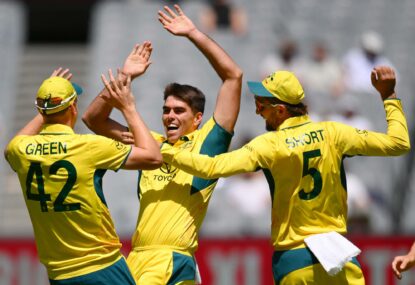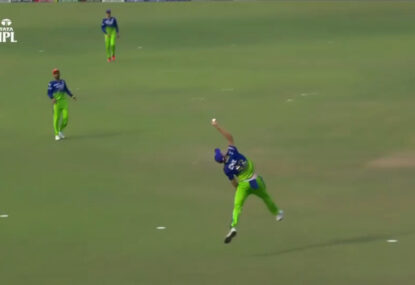Seven editions of the Big Bash League have achieved a major thing for Cricket in Australia, other than filling the coffers. It has brought tribalism back to summer.
Fans have been able to identify with teams during the summer, something normally reserved for the winter footy codes, for the first time in more than 20 years.
During the hot Australian summer, where the Aussie cricket fan has traditionally united to support the baggy green, we are seeing the fans turn more and more towards their BBL teams.
Tribalism is alive and well in the BBL.
Crowds at the BBL over the first seven editions (2011-12 to 2017-18) have averaged 23,785. Figures like this in domestic cricket in Australia have not been seen since the 1970’s and 1980’s, if ever!
Young supporters have enjoyed the opportunity to see their heroes regularly, at a convenient time of year – the summer school holiday period – but also the opportunity to see international superstars.
Domestic cricket has lacked the drawing power of Australia’s best players for the best part of 20 years, but that has changed with the BBL, where our best are out there when they can be.
The WACA ground in Perth, which has hosted three of the seven BBL finals, sold out almost every home match in BBL07, averaging 21,519. The Scorchers then played their home semi-final against the Hobart Hurricanes in front of 52,960 fans at the new Perth Stadium.
The last time domestic crowd figures at the WACA were so good was a one-off Mercantile Mutual Cup Match in early January 2001, when 15,000 odd fans turned up to see the Western Warriors recover from 3/5 to post 230 and score a seven-run victory over a Victorian Bushrangers side including Shane Warne on the comeback from injury. The crowd were there to see Shane Warne!
Supporters at the WACA were privileged in the 70’s and 80’s to see some of the greats, including Dennis Lillee and Rod Marsh, do their thing for WA. They were also able to see the Chappell brothers (Ian and Greg), Jeff Thomson, Doug Walters, David Hookes, Max Walker and Allan Border regularly. These legends were the draw cards.
Herschelle Gibbs, Shane Warne, Kevin Pietersen, Brad Hodge, David Hussey, Brendon McCullum, Steve Smith, Mike Hussey, David Warner, Dwayne Bravo, Kieron Pollard, Lasith Malinga, Chris Gayle, Jacques Kallis, Brad Hogg, Mitchell Johnson, Mahela Jayawardene, all superstars of international cricket, have been visible to fans across the first seven editions of the BBL.
It’s no wonder fans are heading along!
Watching these superstars regularly has led to supporters showing what sport psychologists refer to as ‘basking in reflected glory‘ and ‘cutting off reflected failure’, attributes we normally associate with the tribalism of our football codes.
Generally speaking, basking in reflected glory means that, when we win, we celebrate and feel or act like we’re part of the team, we talk about “we” and not “them”. When our team loses, cutting off reflected failure sees us tend to cut ourselves off and not identify as a supporter of that team and we remove ourselves so far that it is “them” not “we”.
The financial opportunities provided by the BBL have seen expansion of the competition.
BBL|01 started with seven matches for each team (they played every other team once), with the semi-finals scheduled for Saturday and Sunday and the final the following Saturday (28th January). However, seven matches meant some teams had three home matches and some four, which was not fair.
BBL|02 saw an expansion to eight matches per team to allow for each team to host four home matches. This also allowed for an extra derby in Sydney and Melbourne, while Adelaide played Perth twice and Brisbane played Hobart twice, hardly rivals. The eight-match season continued for five years until the end of BBL|06.
During these five seasons, the BBL administrators worked out that the best timeframe for the competition was midweek semi-finals with the final completed before the end of the summer school holidays. The one exception to this was BBL|03, which did not finish until the seventh of February.
In BBL|07 (2017-18) expansion saw the addition of an extra two matches (ten total) for each team pushed the finals back one week outside of the school holiday period.
It allowed for teams to take an extra home game to non-traditional cricket venues such as Kardinia Park in Geelong, Traeger Park in Alice Springs, Manuka Oval in Canberra and York Park in Launceston.
Despite the fall in average attendances (except for Perth) in BBL|07, Cricket Australia pushed ahead with their expansion plans. Not more teams, but more matches.
BBL|08 now sees the competition expanded to a full round robin, with an extra four matches bringing the total to 14 for each team.
This has allowed for further addition of Carrara Oval on the Gold Coast and Ted Summerton Reserve in Moe, bringing the number of venues used to 15, further expanding opportunity for each franchise to build fanbases.
It has meant a tighter schedule, with teams having slightly shorter breaks between games on average, but also an extended time frame.
The BBL|08 final will not be played until Saturday, February 17, the latest final in the eight editions of the BBL and well and truly into the start of the first school term.

Members of the Sydney Thunder. (Photo: Cameron Spencer/Getty Images)
At the end of December, Cricket Australia CEO Kevin Roberts reported a 14 per cent drop in BBL crowd figures to the same point in time in BBL|07- is it perhaps to do with the struggles of the national team in the wake of sandpaper-gate?
Or is the recent trend of top Australian players missing from the BBL making it less enticing for the fans? Or, is it simply that now fans have seven matches they can attend as opposed to previous seasons where there were only four?
If the decreasing trend in attendance continues, has the bubble burst for Twenty20 cricket in Australia?
It is hard to tell at this point, particularly after the rapid growth and success of the first seven editions and even more so recently with the rapid growth in the Women’s BBL.
Some of the scheduling leaves a little bit to be desired, with the Perth Scorchers scheduled to take on one of their fiercest rivals, the Melbourne Stars, at 6:15pm (AWST) on Sunday the third of February, the day before students return to school in Western Australia.
I don’t know many parents that would be willing to take their children to a BBL match that is unlikely to finish before 9:30pm, and therefore not have their children home and in bed before 10.30pm, the night before the school years starts!
Kids and adults alike wear their team’s apparel in public, they fill stadiums with their colours. It would be a shame for Cricket Australia to lose that interest in domestic cricket in the pursuit of the dollar.
Crowd figures and TV audiences in the last two weeks of BBL|08 will be telling and may determine if a more compact schedule is required to maintain interest and keep attendances high.
Hopefully, for the sake of the supporters, a logical decision is made, because the tribalism that has developed over the past eight years borders on the fanaticism that we only see with the winter footy codes and it has been a breath of fresh air to cricket in Australia.





































































































